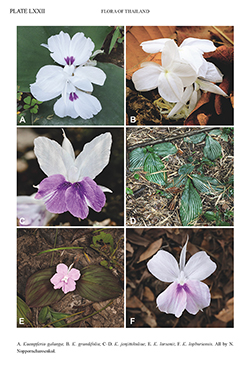e-Flora of Thailand
Volume 16 > Part 2 > Year 2023 > Page 620 > Zingiberaceae > Kaempferia
8. Kaempferia galanga L.wfo-0000451725
Sp. Pl.1: 2. 1753; Hort. Cliff.: t. 3. 1737; Sims, Bot. Mag. 22: t. 850. 1805; Redouté, Liliac. 3: t. 144. 1807; Roscoe, Trans. Linn. Soc. London 8: 351. 1807; Willdenow, Enum. Pl.: 5. 1809; Roxb., Asiat. Res. 11: 327. 1810; Hort. Bengal.: 1. 1814; Fl. Ind. 1: 14. 1820; Blume, Enum. Pl. Javae 1: 47. 1827; Roscoe, Monandr. Pl. Scitam.: t. 92. 1828; Roxb., Fl. Ind., ed. 1832: 15. 1832; Schumann, Pflanzenr. IV, 46 (Heft 20): 77. 1904; Valeton, Bull. Jard. Bot. Buitenzorg (series 2) 27: 108. 1918; Kirtikar & Basu, Ind. Med. Pl. 5(2): 1252. 1918; Ridl., Fl. Malay Penins. 4: 245. 1924; Holttum, Gard. Bull. Singapore 13: 121. 1950; Sirirugsa, Nordic J. Bot. 9: 259. 1989; Thai Forest Bull., Bot. 19: 11. 1992; Kress et al., Contr. U.S. Natl. Herb. 45: 122. 2003; Newman et al., Blumea, Suppl. 16: 119. 2004; Picheans. & Koonterm, J. Thai Trad. Alt. Med. 6(1): 80. 2008. Plate LXXII: A.
Accepted Name : This is currently accepted.
Synonyms & Citations :
Description : Perennial herb, to 2 cm tall; rhizome subglobose to compressed globose, moniliform. Leaves 2, sessile; blades orbicular to broadly elliptic, 11–16 by 10.5–16 cm, base rounded, apex acute. Inflorescence terminal, apical ⅓ only exserted from sheaths; bracts triangular, to 3.6 by 1.3 cm, apex acute, pale green with red to green apex; bracteoles 2, keeled, 2.5–3 by 0.1–0.2 cm. Flowers 17–20 per inflorescence; ovary ellipsoid, ca 3 by 1.5–1.8 mm, white, sparsely pilose; stigma compressed, cup-like, 1.5–2 by 0.5 mm, ostiole ciliate; epigynous glands linear, to 5.5 mm long, cream; calyx ca 3 cm long, membranous, white, split 9 mm on one side, bilobed, apex acute and mucronate; floral tube 3–3.7 cm long, white, dorsal corolla lobe lanceolate, ca 2.8 by 0.5 cm, apex acute, cucullate, ca 0.5 mm long, lateral corolla lobes narrowly lanceolate, ca 2.8 by 0.5–0.7 cm, apex acute, mucronate, white; lateral staminodes narrowly obovate, ca 2.6 by 0.9 cm, base cuneate, clawed at base, apex acute; labellum narrowly ovate, 2.4–2.5 by 1.2 cm, bilobed, lobes elliptic-circular, 1.1–1.2 by 0.9–1 cm, apex shallowly bilobed and dentate, purple with dark purple at base, with white margin in basal half, with yellow midband and purple parallel band at midrib margin; stamen: filament ca 2 mm; anther ca 3.5 by 2 mm, anther crest ovate to crenulate, ca 5 by 3.5 mm, apex shallowly bilobed by 1–1.2 mm. Fruit oblong; seeds obovate, aril white.
Thailand : Widespread.
Distribution : Bangladesh, Cambodia, China, India (type?), Indonesia, Laos, Malaysia, Myanmar, Singapore, Vietnam.
Ecology : Shady places in deciduous forests. Flowering: July–September.
Vernacular : Krachae chan (กระแจะจันทร์), pro hom (เปราะหอม), tup mup (ตูบหมูบ).
Uses: The young leaves are eaten as a fresh vegetable and the rhizome is used to flavour fish curry. A volatile oil extracted from the rhizome is used in rituals.
Notes: The colour of the lateral staminodes and labellum of Kaempferia galanga varies from white to pink and the colour of the leaves from green or greyish green to dark purple. The leaf shape varies from elliptic to orbicular. Kaempferia marginata sensu Sirirugsa (1992) is an intermediate population of K. galanga and K. marginata Carey ex Roscoe, having white lateral staminodes (as in K. galanga) and a pink labellum (as in K. marginata). Kaempferia mahasarakhamensis is another variation of K. galanga with broadly elliptic leaves and green to red margins. Here, we treat K. mahasarakhamensis as a synonym.

